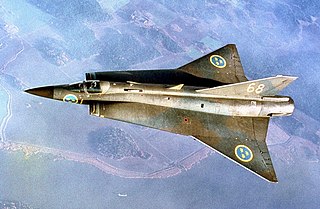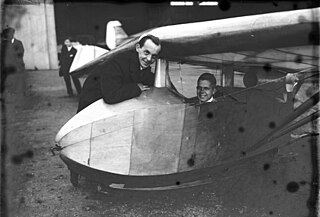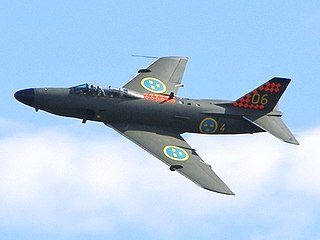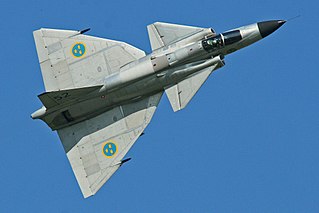
The Saab 37 Viggen is a single-seat, single-engine multirole combat aircraft designed and produced by the Swedish aircraft manufacturer Saab. It was the first canard-equipped aircraft to be produced in quantity and the first to carry an airborne digital central computer with integrated circuits for its avionics, arguably making it the most modern/advanced combat aircraft in Europe at the time of introduction. The digital central computer was the first of its kind in the world, automating and taking over tasks previously requiring a navigator/copilot, facilitating handling in tactical situations where, among other things, high speeds and short decision times determined whether attacks would be successful or not, a system not surpassed until the introduction of the Panavia Tornado into operational service in 1981.

A delta wing is a wing shaped in the form of a triangle. It is named for its similarity in shape to the Greek uppercase letter delta (Δ).

The Saab 35 Draken is a Swedish fighter-interceptor developed and manufactured by Svenska Aeroplan Aktiebolaget (SAAB) between 1955 and 1974. Development of the Saab 35 Draken started in 1948 as the Swedish air force future replacement for the then also in development Saab 29 Tunnan day fighter and Saab 32B Lansen all-weather fighter. It featured an innovative but unproven double delta wing, leading to the creation of a sub-scale test aircraft, the Saab 210, which was produced and flown to test this previously unexplored aerodynamic feature. The full-scale production version entered service with frontline squadrons of the Swedish Air Force on March 8, 1960. It was produced in several variants and types, most commonly as a fighter-interceptor.
Supercruise is sustained supersonic flight of a supersonic aircraft without using afterburner. Many supersonic military aircraft are not capable of supercruise and can maintain Mach 1+ flight only in short bursts with afterburners. Aircraft such as the SR-71 Blackbird are designed to cruise at supersonic speed with afterburners enabled.

A vertical and/or short take-off and landing (V/STOL) aircraft is an airplane able to take-off or land vertically or on short runways. Vertical takeoff and landing (VTOL) aircraft are a subset of V/STOL craft that do not require runways at all. Generally, a V/STOL aircraft needs to be able to hover. Helicopters are not considered under the V/STOL classification as the classification is only used for aeroplanes, aircraft that achieve lift (force) in forward flight by planing the air, thereby achieving speed and fuel efficiency that is typically greater than the capability of helicopters.

Alexander Martin Lippisch was a German aeronautical engineer, a pioneer of aerodynamics who made important contributions to the understanding of tailless aircraft, delta wings and the ground effect, and also worked in the U.S. Within the Opel-RAK program, he was the designer of the world's first rocket-powered glider.

The Gloster Javelin is a twin-engined all-weather interceptor aircraft that served with Britain's Royal Air Force from the mid-1950s until the late 1960s. It was a T-tailed delta-wing aircraft designed for night and all-weather operations and was the last aircraft design to bear the Gloster name. Introduced in 1956 after a lengthy development period, the aircraft received several upgrades during production to its engines, radar and weapons, including support for the De Havilland Firestreak air-to-air missile.

The Saab 32 Lansen is a two-seat, transonic military aircraft designed and manufactured by the Swedish aircraft manufacturer Saab AB.

The Saab 29 Tunnan, colloquially also Flygande Tunnan, is an early jet-powered fighter aircraft designed and produced by the Swedish aircraft manufacturer Saab. It was the second turbojet-powered combat aircraft to be developed in Sweden, the first being the Saab 21R, and it was the first Western European fighter to be produced with a swept wing after the Second World War, only being preceded in Western Europe as a whole by the Messerschmitt Me 262 built during the conflict.

The Avro 707 is an experimental aircraft designed and produced by the British aircraft manufacturer Avro.
Aarne Lakomaa (1914–2001) was a Finnish aircraft designer. Born in Finland, Lakomaa graduated from Helsinki Polytechnics. He fought as an Army Lieutenant in the Winter War (1939–40) and the Continuation War (1941–44) against the Soviet Union. There he became famous for fitting captured Russian engines to the obsolete French fighter Morane-Saulnier M.S.406, thereby creating a first rate fighter, the Mörkö-Morane. Aarne Lakomaa first replaced the original Hispano-Suiza 12Y 31 liquid-cooled V-12 rated at 860 hp with a 1,100 hp Soviet engine— the Klimov M-105P—which was a war booty. This engine was installed under the cover of a more aerodynamic cowling and fitted with a different pitch propeller. The French M.S.406's airframe was strengthened, and an oil cooler from a Messerschmitt-109 replaced the old one. In this way over-heating problems was finally solved. As a result of these modifications, the improved version of Morane had a 36-mph speed advantage over all previous versions.

The General Dynamics F-16XL is a derivative of the F-16 Fighting Falcon with a cranked-arrow delta wing. It entered the United States Air Force's (USAF) Enhanced Tactical Fighter (ETF) competition in 1981 but lost to the F-15E Strike Eagle. The two prototypes were shelved until being turned over to NASA for additional aeronautical research in 1988. Both aircraft were fully retired in 2009 and stored at Edwards Air Force Base.

The Fairey Delta 2 or FD2 is a British supersonic research aircraft that was produced by the Fairey Aviation Company in response to a specification from the Ministry of Supply for a specialised aircraft for conducting investigations into flight and control at transonic and supersonic speeds. Features included a delta wing and a drooped nose. On 6 October 1954, the Delta 2 made its maiden flight, flown by Fairey test pilot Peter Twiss; two aircraft would be produced. The Delta 2 was the final aircraft to be produced by Fairey as an independent manufacturer.

A supersonic aircraft is an aircraft capable of supersonic flight, that is, flying faster than the speed of sound. Supersonic aircraft were developed in the second half of the twentieth century. Supersonic aircraft have been used for research and military purposes, but only two supersonic aircraft, the Tupolev Tu-144 and the Concorde, ever entered service for civil use as airliners. Fighter jets are the most common example of supersonic aircraft.

In aeronautics, a canard is a wing configuration in which a small forewing or foreplane is placed forward of the main wing of a fixed-wing aircraft or a weapon. The term "canard" may be used to describe the aircraft itself, the wing configuration, or the foreplane. Canard wings are also extensively used in guided missiles and smart bombs.

The Hawker P.1103 was a design by Hawker Aircraft to meet the British Operational Requirement F.155; it did not progress further than the drawing board.

Otto Hermann Bernhard Behrbohm, born 30 October 1907 in Karlsruhe, Grand Duchy of Baden, Imperial Germany; died 12 October 1977 in Fingelsham, Northbourne, Kent, United Kingdom, was a German mathematician active in Sweden and Germany.

Bertil Dillner was a Swedish aeronautical engineer and aerodynamic expert. He was significant in the development of delta wing aerodynamics and supersonic flight concepts. Dillner served for many years as manager of Boeing engineering design offices.

Erik Gustaf Bratt was a Swedish engineer and pilot. Erik Bratt was the brother of Colonel Lars Bratt.



















